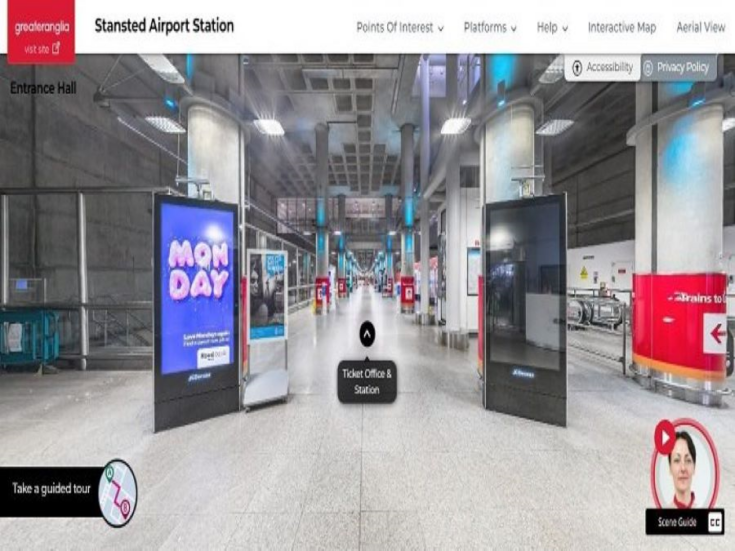
The web-based online virtual tour is offering potential passengers autopilot or manual choices when navigating the station. Users of the technology can choose the location within the station that they want to view and be automatically guided to it, or they can choose to click through the pages by themselves.
There is an interactive map that allows users to view the station layout in its entirety, as well as click on links to navigate specific areas of the station. The platform aims to increase reassurance relating to accessibility and general safety of passengers at the station.
A Greater Anglia spokesperson says: “The tour has been designed to support journey planning, give customers a clearer picture of the station before they travel and reduce anxiety about how they’ll get around from car park to platform to airport.”
The tour uses 360-degree photography, aerial photography and an interactive map to locate customer facilities. The technology covers other public areas of the station which includes the entrance, toilets, customer service desk or ticket office, platforms, lifts, café car parks and drop off areas.
There is an aerial view of the car park, cycle parking, bus stop and taxi rank/drop off location, while tactile paving which is textured paving on the edge of platforms, travel meeting points can be viewed on the drop-down menu.
The spokesperson says: “This gives you the closest experience to physically being there. Customers can take their time to have a good look around without the pressures of actual travel.
“It gives people a visual guide and a spoken tour through the station. This is empowering for the customer as it enables them to decide what is an isn’t a barrier for their journey rather than be told whether something is or isn’t accessible.”
There is a spoken scene guide with closed captions on the home page and an accessibility widget which enables users to change the layout options which include large font size, high contrast or audio transcribe. Informed journey planning is key to some passengers and these features are helpful for this reason.
Implementing the virtual tour technology in relation to the rail station involved many challenges. Greater Anglia searched for a provider to adapt the technology which would be used in the dynamic and diverse station environment while making it accessible. Virtual Tours Experts made this possible.
The station had to be filmed at a quiet time where there were few customers using it. This was essential to ensure clarity in relation to making sure passengers get a detailed idea of locations within the station. In addition, permission for aerial footage was required.
Greater Anglia and Virtual Tours Experts overcame technical constraints in order to make the technology usable on platforms such as mobile devices as well as computers.
The virtual tour can be particularly useful for disabled customers when checking how accessible their journey is. Greater Anglia’s Accessibility Panel consists of a group of disabled customers who meet regularly with the company to share feedback relating to the project. The members have shared their support for the virtual tour idea throughout.
Stansted Airport station has step-free access, accessible ticket machines, accessible ticket office counters and a ramp is available for train access. Some new trains also serve the station, these trains have a retractable step so it is possible for passengers in wheelchairs and scooters to board without a ramp.
While trained staff are also available to support customers with access needs, the virtual tours further enhance journey planning for passengers arriving at the station.
The aim will be to create 360-degree virtual tours for ten stations which become very busy and could potentially be more difficult to navigate as a result.
There are also virtual tours available for passengers using Norwich and Cambridge stations. Virtual Tours Experts is also expecting to make tours of Bishops Stortford, Broxbourne, Chelmsford, Colchester, Ipswich, Shenfield and Southend Victoria available to members of the public.
Greater Anglia also aims to include British Sign Language videos to support customer information in the future.










More Stories
Powering Business Resilience: How Expert Technical Support Transforms Modern Enterprises
The Challenges of Modern Data Ecosystems Most Startups Don’t Envisage
Level Up Instantly: The Fastest Way to Buy Free Fire Diamonds in 2025